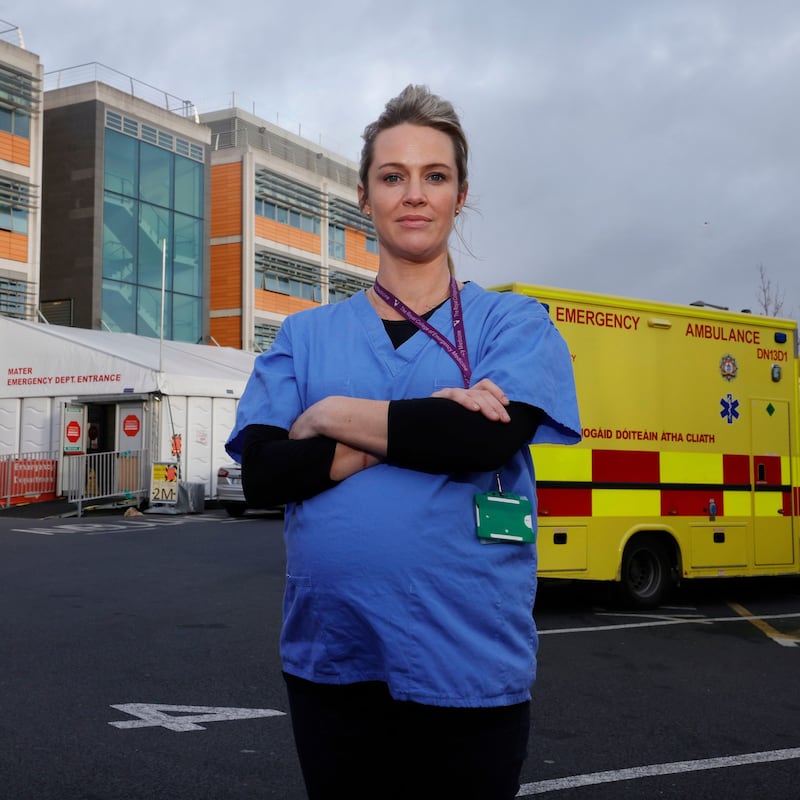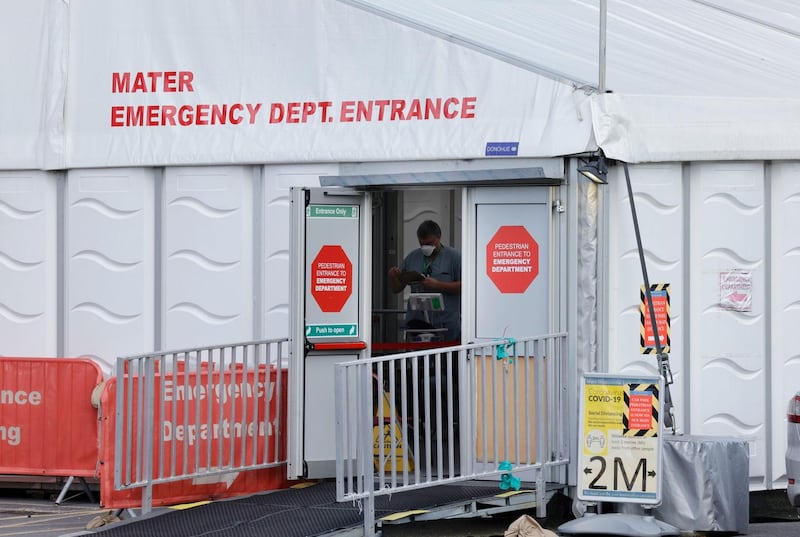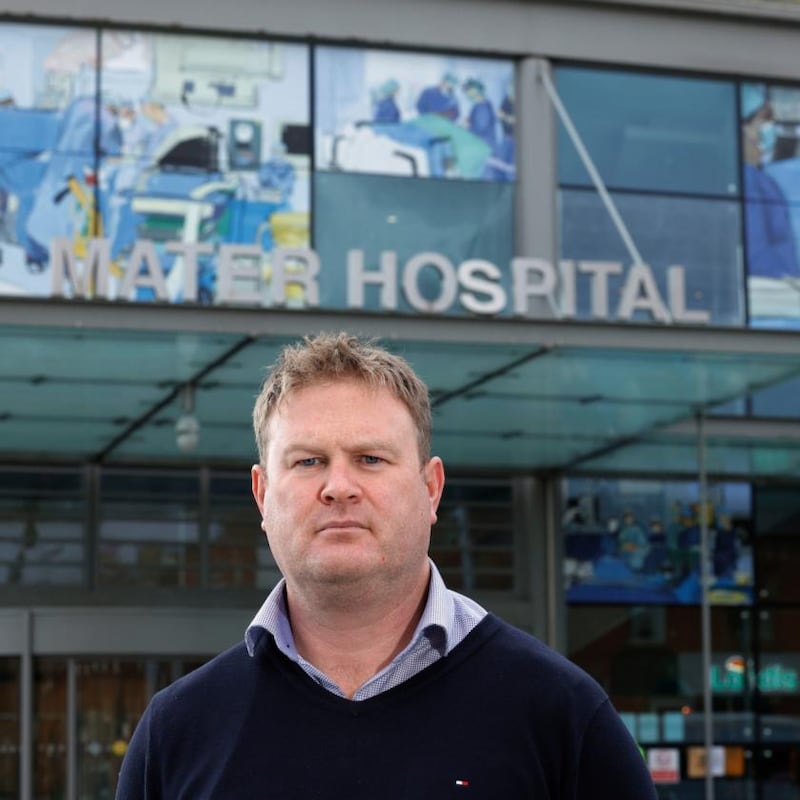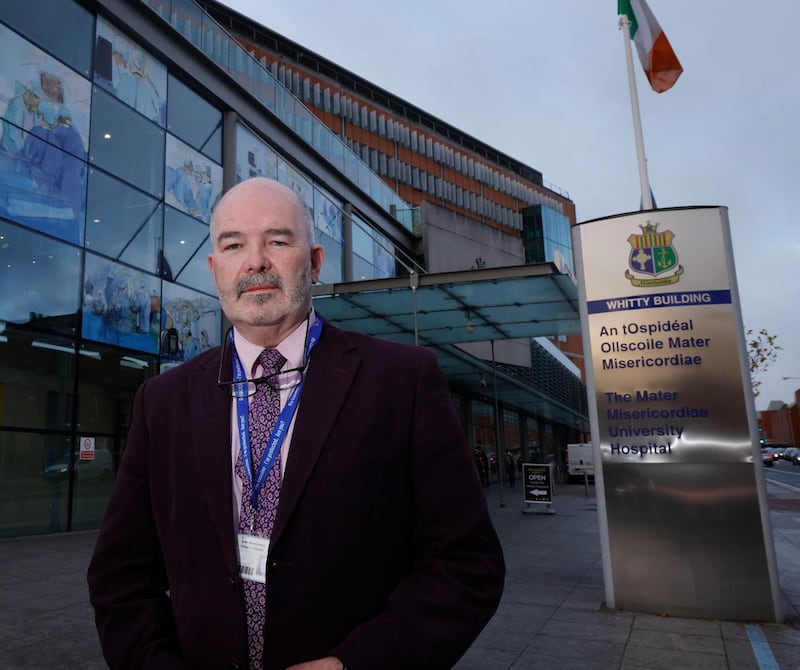It is 9am on Thursday. Dr Sinead McArdle has just arrived to start her shift in the emergency department at Mater Misericordiae University Hospital, in Dublin.
Since the beginning of the Covid-19 pandemic there have been only a few moments when she has been genuinely scared. Now is one of those times. In the beginning, staff at the hospital felt the public were on their side. “They stayed at home. They washed their hands. They wore their masks. They stayed within their 5k. They helped us.
I'm scared now because every day we are literally teetering on the edge in the health service
“Now I’m scared because that’s going away.” The pandemic “is just getting worse and worse. And the deaths will start to increase. I’m scared now because every day we are literally teetering on the edge in the health service. It might just take an extra 500 cases or 1,000 cases in the community, and we’re going to tip over the other side. We’re not going to be able to manage and people will die, again.”
At 36 weeks pregnant – this will be her second “Covid baby”; her son is 15 months old – she knows what it is to be tired. “I understand that people are tired, but Covid is not going away. We have to learn to live with it. We have to learn and get a balance of what we can do in the community safely.”

Until her shift ends, at 6pm or 7pm, she will be one of three emergency-care consultants on duty. Recently, about 250 people a day – often more – have been attending the hospital’s emergency department, or ED. “We think we might surpass 90,000 ED presentations this year.” Last year the figure was 74,000. With staff missing because of Covid, trying to keep up with the demand “is just getting harder”.
One of the emergency consultants will spend the day in the marquee outside the department, streaming patients into Covid- or non-Covid pathways, and trying to persuade those who don’t need to be here not to come in, because they’ll be waiting 10 or 12 hours and putting themselves at risk.
“I would say at least 50 per cent of the [patients] coming through the ED are considered query Covid.” Some of those are “known Covid positive and are deteriorating”. And if they are unvaccinated “we can already plan their trajectory. We know it is going to be worse.”
Having done all her research, she decided to get vaccinated while pregnant – "my happiest day was the day I was offered my vaccine" – and she recently had her booster. There are currently young pregnant women in ICU at the Mater, and McArdle is anxious that others understand that the vaccine is safe and effective.
If the unvaccinated people could see how sick young people are getting – and not people with significant underlying health concerns – it would really open up their eyes
She suggests that if people who have chosen not to be vaccinated “could see what we see in the hospital, if the unvaccinated people could see how sick young people are getting – and not people with significant underlying health concerns – it would really open up their eyes.”
I ask her to tell me. She describes two patients presenting with similar respiratory symptoms; one vaccinated, the other not. Unless they have a major illness, the vaccinated person will “feel like they’ve had a head cold, they have a cough, they’ve got aches and pains”. Almost always, they can go home for rest, fluids and paracetamol.
The unvaccinated person is “going to be straight on oxygen. Sometimes their oxygen saturation is so low you’re looking at them and you’re thinking, Are their oxygen levels really that low? And then some will need oxygen via a noninvasive mask. Maybe a line in their neck, to give them certain medications, and a line into the artery in their wrists to keep a constant record of their oxygen and blood pressure. A proportion of those will go to intensive care and need intubation.
“And if you get to that stage, where they have a really bad X-ray” showing “Covid pneumonitis, they’re going to be in ICU for 10 days at a minimum, and sometimes much longer. They’ll get better. But after you’ve had a prolonged ICU stay there are lots of complications. You have to learn to do everything again.”
This wave feels similar to the way colleagues described the third wave, last January and February, when she was on maternity leave; the sensation that you’re “on a knife edge all the time”.
But there’s one critical difference. “It’s a pandemic, this time round, of the unvaccinated. They’re the people who are very sick and are taking up that that higher percentage of ICU care, critical care, emergency resuscitation care.”
I WAS LAST here at the Mater as a reporter in early June 2020, as we were nearing the end of the first wave and what we hoped might prove to be the end of the pandemic. Staff were tired and slightly shell-shocked, but there was a sense that a normality of sorts was beginning to return.
The atmosphere today is markedly different. As before, I wear PPE and strictly adhere to the hospital’s infection-prevention controls, including social-distancing and hand-sanitising protocols. But this time no interviews take place on the wards – all are in meeting rooms on the floor where the hospital management have their offices, far away from patients. No nurses are available to talk – they are too busy – and no photography is allowed inside the hospital.

On November 12th the Mater announced that it was limiting activity to essential services only and that outpatient appointments and elective surgeries would be curtailed until further notice.
Earlier this week the hospital's head of ICU and president of the Intensive Care Society of Ireland, Dr Colman O'Loughlin, went on RTÉ radio to warn that the situation at the hospital was grim. He agrees to an interview this morning because he believes it is essential the public understand how dire the situation is.
This is how dire it is: the Mater has 34 critical-care beds, and today half of them are filled with Covid patients, ranging in age from 28 upwards. The number of Covid-positive patients in ICU is 12, and there are five in the high-dependency unit, or HDU. The rest are filled with non-Covid patients.
You're asking one intensive-care nurse who is usually very busy looking after one very sick patient to look after two. That's a dilution of care
These 34 beds are all included in the 300 critical-care beds available nationally, even though they include both ICU and HDU beds, which means the Mater is already effectively operating at surge level. “You’re asking one intensive-care nurse who is usually very busy looking after one very sick patient to look after two. That’s a dilution of care,” he says.
The night before we meet, Nphet's chief epidemiological advisor, Dr Philip Nolan, shared several scenarios for how the situation in the country's hospitals might play out if we don't take action. The "optimistic scenario" he outlined "sees about 1,000 in hospital and 200 in critical care" in December. The "pessimistic scenario" would see more than 2,000 people in hospital and at least 400 requiring critical care. "These people couldn't all be cared for in ICU. Many would receive advanced respiratory support on wards and in high-dependency units," he said.
“Even the language around optimistic scenarios makes me nervous,” says O’Loughlin, who is noticeably more subdued and downbeat than the last time we met, in June 2020. “There’s only pessimism and carnage. There’s no optimistic scenario.”
He worries that talk of up to 400 people needing to be in ICU is “false language. There’s only 300 ICU beds in the country. So even if 500 require ICU beds only 300 will get them, and they’ll be a mixture of Covid and non-Covid. There’ll be cardiac arrest, there’ll be bad pneumonias, there will be pancreatitis, and there will be Covid. And we’ll have nowhere to put those patients.”
Some reports recently suggested that some patients could be looked after on the ward with oxygen, but he says this is not the case. “The reason they’re being referred to [critical] care is because that piece of looking after them on the ward with oxygen has failed.”
Who will get the ICU beds – Covid or non-Covid? If it's Covid, is it vaccinated or unvaccinated? They're really, really, really terrible questions to think about
If ICU and HDU both fill up, “the problem is not necessarily location” of extra beds, it’s staffing. Staff who are not trained to work in the ICU are understandably reluctant and fearful of taking on such a significant responsibility. On top of this, there are “only a limited number of spaces in the hospital where you can plug in oxygen machines”.
All of this means, O’Loughlin says, that “surge is an abstract concept. Those beds aren’t real … So your 18- or 19-year-old son comes in with appendicitis, I have no idea if we’ll be able to offer that person timely surgery. Something like appendicitis becomes extremely hazardous.”
If Nolan’s projections “come even close, that is close to the implosion of the health service”.

O’Loughlin worries about the impossible decisions that he and others in his position may soon face. “We’ve obvious problems around who gets the ICU beds – Covid or non-Covid? If it’s Covid, is it vaccinated or unvaccinated? They’re really, really, really terrible questions to think about.”
Is he already thinking that way? “I think about it all the time. There’s certainly a discussion going on among people” in healthcare “about how do you decide, when ICU is full, what kind of patient gets a bed..? Nobody has an answer to say, if you have two patients, which of the two” should get a bed. “It will come down to clinical need and who’s likeliest to benefit.” So far “we’ve been moving patients from one hospital to another to avoid having to do that”.
Already this morning he has had two phone calls from hospitals elsewhere in the country looking for critical-care beds for young unvaccinated people.
O'Loughlin sees another lockdown as almost inevitable. 'I can't see how we're going to get away without it. And no one wants it, including myself'
Of the unvaccinated patients ending up in ICU, “a lot of them are from countries where English isn’t their first language”. He thinks “it’s a cultural position in some minority groups, where anything that’s sponsored by the state is to be distrusted, to be suspected. If you look at some eastern European countries, for example, their own vaccination rates are very, very low.”
He points to Romania, where the vaccination rate is currently about 36 per cent. “We’re seeing a similar ratio in the eastern European population in this country.” Better communication is needed to reach populations where vaccination rates are low and English is not the first language, he suggests.
The fully vaccinated patients who end up in critical care are typically, in “the vast majority” of cases, “people whose immune systems really are very compromised”. Even if we had 100 per cent vaccination we would still have high numbers of people getting sick, because “this virus is circulating widely and there’s an awful lot of people who are vulnerable” because of other medical conditions.
Booster shots offer hope. O’Loughlin is impatient to see them “going into arms” instead of being left in fridges. So too, in time, might antiviral drugs and a vaccine that can be delivered nasally, which may have an impact on transmission. In the meantime, though, he sees another lockdown as almost inevitable. “I can’t see how we’re going to get away without it. And no one wants it, including myself. I’ve seen what it has done to children, to vulnerable people, and people with mental-health issues.”
If we go into a repeat of last Christmas, we're coming into it from a far worse space, and it's potentially very, very catastrophic
But he believes we may be left with little choice. It will be up to the Government and the public it represents, he says. This week’s new rule to close nightclubs at midnight was a signal, he thinks, that the Government is prepared to take further action. “If society wants this transition from pandemic to endemic to be another wild flush through society, then so be it. We’ll stand back and watch thousands of people die if that’s what society wants. But I don’t think it is what society wants.
“It’s within the gift of each individual to try and prevent that by taking actions … I’m not advocating for lockdown,” but “…if we go into a repeat of last Christmas we’re coming into it from a far worse space, and it’s potentially very, very catastrophic.”
PROF JOHN MCCAFFREY started his day hours earlier on a lower floor of the hospital. Here in the Mater's oncology unit the after-effects of the past 20 months are now being felt. No patient's treatment for cancer was postponed or interrupted as a result of the pandemic, but missed or delayed diagnoses have meant that some people never got started on treatment at all.
“What we’re seeing in the last 18 months, particularly, is far fewer people than we would [normally] see with an early-stage cancer who just need surgery and maybe surveillance. And we’re seeing far more people who have advanced disease – delayed presentations who then need more complicated, multidisciplinary care with the combination of surgery, maybe radiation treatment, complex chemotherapy and immunotherapy and hormone treatments,” he says.
“Most of the patients I’ll see today are people who, last year or two years ago, we wouldn’t have had to treat them. We would have been saying you’ve been cured with surgery and you just need surveillance. Now they may have advanced disease.”

It is “a cancer pandemic. It’s also been described as a tsunami of cancers. It’s what we feared, and I don’t think we’ve come near the peak of it yet.”
He gives the example of testicular cancers. “This year we’ve had maybe double the numbers, and they all need chemotherapy, which is unusual.”
What gives him solace is the team spirit he sees in the oncology unit and across the hospital. “The team here have been amazing. We’re often quick to be critical of what doesn’t work, but, as much as it’s scary, and people’s lives are affected and survivors are affected, the team approach has been inspirational.”
The HSE has made extra funding available to help deal with the cancer pandemic, including to expand the role of advanced nursing practitioners. But, “unfortunately, I don’t think it’s going to be a lost one year to catch up. It’s probably going to be five or 10 years.”
DR EAVAN MULDOON, consultant in infectious diseases at the Mater, is at home caring for a sick child today, and speaks to me via Zoom. One of the unexpected phenomena to emerge from the pandemic is that "older patients are frailer. So they're staying in hospital longer; they require a kind of a prolonged rehabilitation period with our physio and occupational-therapy colleagues."
This may be connected to extensive periods of isolation. “A lot of our older population adhered to the idea of cocooning during the first waves. And we know that the less activity people do, the more likely they are to become frail.”
Last January was extraordinarily tough. But vaccination was rolling out and it felt like that little glimmer of hope. This time I see the exhaustion in my colleagues, I see it in myself, I see it in the general population
This period has been one of the toughest of the pandemic. “I’m a bit despondent, to be honest. Last January was extraordinarily tough. But vaccination was rolling out and it felt like that little glimmer of hope. This time I see the exhaustion in my colleagues, I see it in myself, I see it in the general population.”
People are frustrated by the messaging, she believes, “but we still need to do the basics. Masks, ventilation, staying home if you’re sick. To control the spread of any contagious disease you have to understand how it’s spread. The vast majority of people acquire Covid by breathing it in. Hand hygiene is fantastic – it’s phenomenal for the other potentially infectious diseases. But in terms of impacting Covid,” she says, we need to focus on limiting the opportunities to breathe it in. She thinks ventilation needs to play a much bigger role in public-health advice.
She agrees with O’Loughlin’s characterisation of the outlook as grim. “Once you’re providing ICU care outside of the ICU, that is not the kind of care we want to provide. If you need intensive care you need to be in the intensive-care unit. I’m worried about the next few weeks. It feels really – and colleagues agree – like that sense of last Christmas, where we all knew we were in for a tough time. And January proved us right.”
















